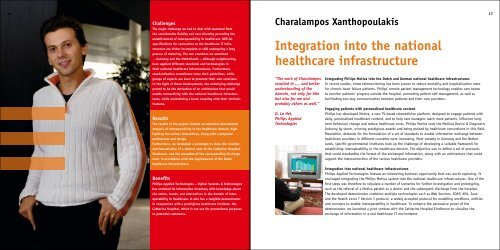Software Technology - Stan Ackermans Institute - TU/e
Software Technology - Stan Ackermans Institute - TU/e
Software Technology - Stan Ackermans Institute - TU/e
Create successful ePaper yourself
Turn your PDF publications into a flip-book with our unique Google optimized e-Paper software.
16<br />
Challenges<br />
The major challenge we had to deal with stemmed from<br />
the considerable fluidity and vast diversity pervading the<br />
establishment of interoperability in healthcare. Official<br />
specifications for connection to the healthcare IT infra-<br />
structure are either incomplete or still undergoing a long<br />
process of maturing. The two countries we examined<br />
– Germany and the Netherlands – although neighbouring,<br />
have applied different standards and technologies in<br />
their national healthcare infrastructures. Furthermore,<br />
standardisation committees issue their guidelines, while<br />
groups of experts are keen to promote their own solutions.<br />
In the light of these developments, the underlying challenge<br />
proved to be the derivation of an architecture that would<br />
enable connectivity with the national healthcare infrastruc-<br />
tures, while maintaining a loose coupling with their intrinsic<br />
features.<br />
Results<br />
The results of the project include an extensive documented<br />
analysis of interoperability in the healthcare domain, high-<br />
lighting the various alternatives, along with a proposed<br />
architecture and design.<br />
Furthermore, we developed a prototype to show the creation<br />
and transmission of a referral note to the Catharina Hospital,<br />
Eindhoven, and the reception of the corresponding discharge<br />
note, in accordance with the requirements of the Dutch<br />
healthcare infrastructure.<br />
Benefits<br />
Philips Applied Technologies – Digital Systems & Technologies<br />
has enriched its information inventory with knowledge about<br />
the status, trends, and alternatives in the domain of inter-<br />
operability in healthcare. It also has a tangible demonstrator<br />
in cooperation with a prestigious healthcare institute, the<br />
Catharina Hospital, which it can use for promotional purposes<br />
to potential customers.<br />
Charalampos Xanthopoulakis<br />
Integration into the national<br />
healthcare infrastructure<br />
“The work of Charalampos<br />
resulted in ..., and better<br />
understanding of the<br />
domain, not only for him<br />
but also for me and<br />
probably others as well.”<br />
D. La Hei,<br />
Philips Applied<br />
Technologies<br />
Integrating Philips Motiva into the Dutch and German national healthcare infrastructures<br />
In recent studies, home telemonitoring has been proven to reduce mortality and hospitalisation rates<br />
for chronic heart failure patients. Philips’ remote patient management technology enables care teams<br />
to monitor patients’ progress outside the hospital, promoting patient self-management, as well as<br />
facilitating two-way communication between patients and their care providers.<br />
Engaging patients with personalised healthcare content<br />
Philips has developed Motiva, a new TV-based telemedicine platform, designed to engage patients with<br />
daily, personalised healthcare content, and to help care managers reach more patients, influence longterm<br />
behaviour change and reduce healthcare costs. Philips Motiva took the Medical Device & Diagnostic<br />
Industry by storm, winning prestigious awards and being praised by healthcare consortiums in this field.<br />
Meanwhile, demands for the formulation of a set of standards to enable information exchange between<br />
healthcare providers in different countries were increasing. Most notably in Germany and the Netherlands,<br />
specific governmental institutes took up the challenge of developing a suitable framework for<br />
establishing interoperability in the healthcare domain. The objective was to define a set of protocols<br />
that could standardise the format of the exchanged information, along with an architecture that could<br />
support the interconnection of the various healthcare providers.<br />
Integration into national healthcare infrastructures<br />
Philips Applied Technologies foresaw an interesting business opportunity that was worth exploring. It<br />
envisaged integrating the Philips Motiva system into the national healthcare infrastructures. One of the<br />
first steps was therefore to stipulate a number of scenarios for further investigation and prototyping,<br />
such as the referral of a Motiva patient to a doctor and the subsequent discharge from the hospital.<br />
The developed demonstrator combines multiple technologies such as Web Services, SOAP, XML, Java<br />
and the Health Level 7 Version 3 protocol, a widely accepted protocol for modelling workflows, entities<br />
and concepts to enable interoperability in healthcare. To enhance the persuasive power of the<br />
demonstrator, we launched a joint venture with the Catharina Hospital Eindhoven to visualise the<br />
exchange of information in a real healthcare IT environment.<br />
17



